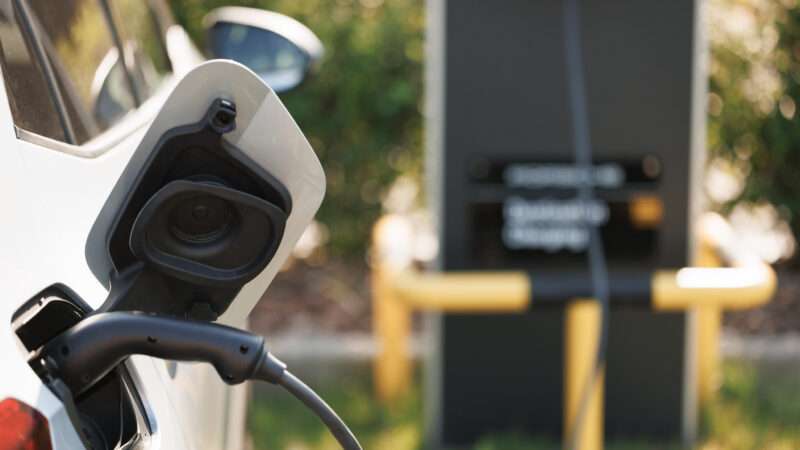
This week, the federal government released new rules that would cut the number of gas-burning cars sold over the next decade. While drafted with good intentions, the move could very well backfire.
On Wednesday, the Environmental Protection Agency (EPA) announced pollution standards for new vehicles produced for model years 2027–2032. The finalized rule calls for "more stringent emissions standards" for passenger cars, SUVs, and light-duty trucks, with the explicit goal of effecting a switch to electric vehicles (E.V.s). By 2032, the rule anticipates, 56 percent of all vehicles sold in the United States will be fully electric, 16 percent will be hybrids, and fewer than 30 percent will rely solely on an internal combustion engine.
The rule was actually relaxed a bit in its final form: When the EPA first announced plans to issue new vehicle standards in April 2023, the proposal would require that 60 percent of all vehicles sold by 2030 be electric, jumping up to 67 percent by 2032.
Still, the rule risks failure, either by asking too much too soon or by prioritizing one particular technology at the expense of viable alternatives.
"A record 1.2 million electric vehicles rolled off dealers' lots last year, but they made up just 7.6 percent of total U.S. car sales," wrote Coral Davenport in The New York Times. That number represented an increase from 5.9 percent the previous year, and E.V. sales in the fourth quarter of 2023 were 52 percent higher than the same period in 2022, representing 8.1 percent of all cars sold.
But even factoring in that uptick, those numbers are not nearly enough to reach the Biden administration's pledged goal, in which more than half of cars sold within the next decade are electric. S&P Global estimates that by 2030, only one in four vehicles sold will be an E.V.—significantly less than the 44 percent the EPA forecasts.
Overall demand is also slowing down, as consumers fret over issues like range, the availability of public chargers, and the higher prices of E.V.s. Without sufficiently addressing those concerns, motorists will not make the switch in sufficient numbers to meet the EPA's timeline.
Last week, the National Automobile Dealers Association (NADA) called the administration's original timeline "too far, too fast," saying that "new vehicle buyers are not purchasing EVs in the quantities necessary for automakers to meet EPA's requirements."
In November 2023, over 3,000 automotive dealers signed an open letter to President Joe Biden, asking that he "tap the brakes" on the mandate and allow time for the market to catch up and for "the American consumer to get comfortable with the technology and make the choice to buy an electric vehicle."
Notably, the rule also favors battery electric vehicles, which use no gasoline and charge when depleted, over hybrids. The EPA expects that its emission standards will ensure 56 percent of vehicles sold in 2032 will be battery E.V.s, while 13 percent will be plug-in hybrids and only three percent will be traditional hybrids.
This, too, is shortsighted: As consumers grow increasingly wary of an all-electric future, hybrids represent an ideal transition between gas and electricity.
Traditional hybrids use a mix of gasoline and electricity, with an electric motor and a gas-powered engine sharing the task. Plug-in hybrids function the same, but the electric motor is much larger and can run on nothing but electricity for short spans of time, providing 20–50 miles of gasoline-free driving before the engine kicks in.
According to the Department of Transportation, the average American motorist drove 37 miles a day in 2021. While any electrified vehicle could handle that trip, hybrids could do so while still allowing motorists the freedom to take longer drives when necessary. While hybrids still generate more carbon emissions than E.V.s, they are a significant improvement over all-gas vehicles.
In fact, automakers have learned this lesson already. As companies like Ford and General Motors (G.M.) pledged billions of dollars to build out their E.V. fleets, Toyota hedged, remaining dedicated to hybrids. Last year, as E.V. sales slowed, Toyota outsold every single competitor, with hybrids comprising one-third of its sales. Meanwhile, Ford and G.M. have each since pared back their planned E.V. investments, and CNBC reported in December that automakers are increasingly following Toyota's lead.
And yet the EPA's new rule not only deprioritizes hybrids, but it may very well skew the market against them. "The EPA's insistence on mandating EVs, to the exclusion of other alternatively-fueled vehicles, greatly reduces consumer choice," the NADA wrote. "This policy will likely cause manufacturers to produce fewer of these alternative vehicles and will increase their cost, thereby dissuading consumers from considering their purchase."
While a switch from gasoline to a more environmentally friendly source of energy is laudable, even perhaps necessary, the transition should be driven by the free market. Implementing a mandate based on an arbitrary timeline is destined to fail, especially since the mandate ignores that hybrids offer a plausible intermediate technology.
The post How the EPA's New Emissions Rule Is Likely To Backfire appeared first on Reason.com.







